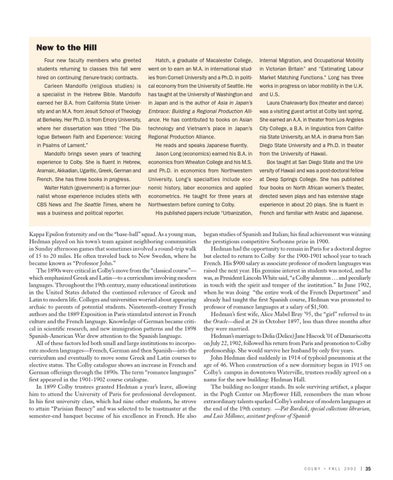New to the Hill Four new faculty members who greeted
Hatch, a graduate of Macalester College,
Internal Migration, and Occupational Mobility
students returning to classes this fall were
went on to earn an M.A. in international stud-
in Victorian Britain” and “Estimating Labour
hired on continuing (tenure-track) contracts.
ies from Cornell University and a Ph.D. in politi-
Market Matching Functions.” Long has three
Carleen Mandolfo (religious studies) is
cal economy from the University of Seattle. He
works in progress on labor mobility in the U.K.
a specialist in the Hebrew Bible. Mandolfo
has taught at the University of Washington and
and U.S.
earned her B.A. from California State Univer-
in Japan and is the author of Asia in Japan’s
Laura Chakravarty Box (theater and dance)
sity and an M.A. from Jesuit School of Theology
Embrace: Building a Regional Production Alli-
was a visiting guest artist at Colby last spring.
at Berkeley. Her Ph.D. is from Emory University,
ance. He has contributed to books on Asian
She earned an A.A. in theater from Los Angeles
where her dissertation was titled “The Dia-
technology and Vietnam’s place in Japan’s
City College, a B.A. in linguistics from Califor-
logue Between Faith and Experience: Voicing
Regional Production Alliance.
nia State University, an M.A. in drama from San
in Psalms of Lament.”
He reads and speaks Japanese fluently.
Diego State University and a Ph.D. in theater from the University of Hawaii.
Mandolfo brings seven years of teaching
Jason Long (economics) earned his B.A. in
experience to Colby. She is fluent in Hebrew,
economics from Wheaton College and his M.S.
Box taught at San Diego State and the Uni-
Aramaic, Akkadian, Ugaritic, Greek, German and
and Ph.D. in economics from Northwestern
versity of Hawaii and was a post-doctoral fellow
French. She has three books in progress.
University. Long’s specialties include eco-
at Deep Springs College. She has published
Walter Hatch (government) is a former jour-
nomic history, labor economics and applied
four books on North African women’s theater,
nalist whose experience includes stints with
econometrics. He taught for three years at
directed seven plays and has extensive stage
CBS News and The Seattle Times, where he
Northwestern before coming to Colby.
experience in about 20 plays. She is fluent in
was a business and political reporter.
His published papers include “Urbanization,
Kappa Epsilon fraternity and on the “base-ball” squad. As a young man, Hedman played on his town’s team against neighboring communities in Sunday afternoon games that sometimes involved a round-trip walk of 15 to 20 miles. He often traveled back to New Sweden, where he became known as “Professor John.” The 1890s were critical in Colby’s move from the “classical course”— which emphasized Greek and Latin—to a curriculum involving modern languages. Throughout the 19th century, many educational institutions in the United States debated the continued relevance of Greek and Latin to modern life. Colleges and universities worried about appearing archaic to parents of potential students. Nineteenth-century French authors and the 1889 Exposition in Paris stimulated interest in French culture and the French language. Knowledge of German became critical in scientific research, and new immigration patterns and the 1898 Spanish-American War drew attention to the Spanish language. All of these factors led both small and large institutions to incorporate modern languages—French, German and then Spanish—into the curriculum and eventually to move some Greek and Latin courses to elective status. The Colby catalogue shows an increase in French and German offerings through the 1890s. The term “romance languages” first appeared in the 1901-1902 course catalogue. In 1899 Colby trustees granted Hedman a year’s leave, allowing him to attend the University of Paris for professional development. In his first university class, which had nine other students, he strove to attain “Parisian fluency” and was selected to be toastmaster at the semester-end banquet because of his excellence in French. He also
French and familiar with Arabic and Japanese.
began studies of Spanish and Italian; his final achievement was winning the prestigious competitive Sorbonne prize in 1900. Hedman had the opportunity to remain in Paris for a doctoral degree but elected to return to Colby for the 1900-1901 school year to teach French. His $900 salary as associate professor of modern languages was raised the next year. His genuine interest in students was noted, and he was, as President Lincoln White said, “a Colby alumnus . . . and peculiarly in touch with the spirit and temper of the institution.” In June 1902, when he was doing “the entire work of the French Department” and already had taught the first Spanish course, Hedman was promoted to professor of romance languages at a salary of $1,500. Hedman’s first wife, Alice Mabel Bray ’95, the “girl” referred to in the Oracle—died at 28 in October 1897, less than three months after they were married. Hedman’s marriage to Delia (Delice) Jane Hiscock ’01 of Damariscotta on July 22, 1902, followed his return from Paris and promotion to Colby professorship. She would survive her husband by only five years. John Hedman died suddenly in 1914 of typhoid pneumonia at the age of 46. When construction of a new dormitory began in 1915 on Colby’s campus in downtown Waterville, trustees readily agreed on a name for the new building: Hedman Hall. The building no longer stands. Its sole surviving artifact, a plaque in the Pugh Center on Mayflower Hill, remembers the man whose extraordinary talents sparked Colby’s embrace of modern languages at the end of the 19th century. —Pat Burdick, special collections librarian, and Luis Millones, assistant professor of Spanish
COLBY
•
FALL 2002
| 35
